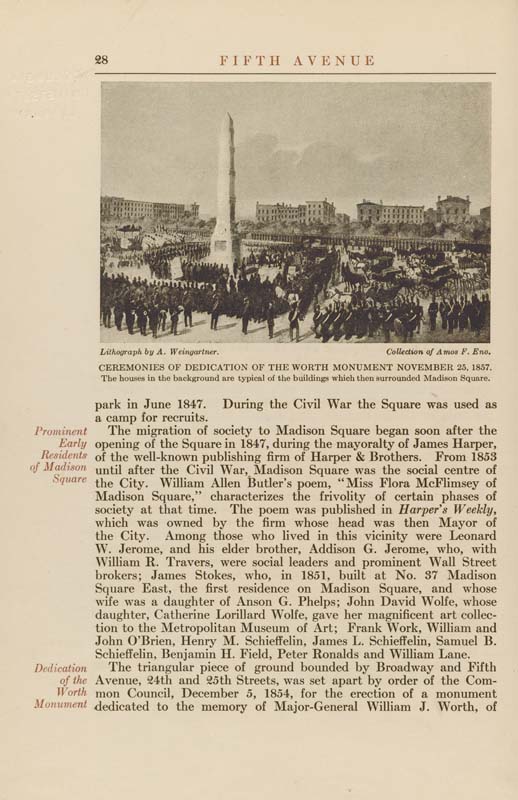28
FIFTH AVENUE
t f i " } i'i 11 • t '1 ^ I #
Lithograph by A. Weingartner.
Collection of Amos F. Eno.
CEREMONIES OF DEDICATION OF THE WORTH MONUMENT NOVEMBER 25. 1857.
The houses in the background are typical of the buildings which then surrounded Madison Square.
Prominent
Early
Residents^
of Madison
Square
Dedication
of the
Worth
Monument
park in June 1847. During the Civil War the Square was used as
a camp for recruits.
The migration of society to Madison Square began soon after the
opening of the Square in 1847, during the mayoralty of James Harper,
of the well-known publishing firm of Harper & Brothers. From 1853
until after the Civil War, Madison Square was the social centre of
the City. Wilham Allen Butler's poem, "Miss Flora McFhmsey of
Madison Square," characterizes the frivolity of certain phases of
society at that time. The poem was published in Harper's Weekly,
which was owned by the firm whose head was then Mayor of
the City. Among those who lived in this vicinity were Leonard
W. Jerome, and his elder brother, Addison G. Jerome, who, with
William R. Travers, were social leaders and prominent Wall Street
brokers; James Stokes, who, in 1851, built at No. 37 Madison
Square East, the first residence on Madison Square, and whose
wife was a daughter of Anson G. Phelps; John David Wolfe, whose
daughter, Catherine Lorillard Wolfe, gave her magnificent art collec¬
tion to the Metropolitan Museum of Art; Frank Work, William and
John O'Brien, Henry M. Schieffelin, James L. Schieffelin, Samuel B.
Schieffelin, Benjamin H. Field, Peter Ronalds and William Lane.
The triangular piece of ground bounded by Broadway and Fifth
Avenue, 24th and 25th Streets, was set apart by order of the Com¬
mon Council, December 5, 1854, for the erection of a monument
dedicated to the memory of Major-General William J. Worth, of
|








